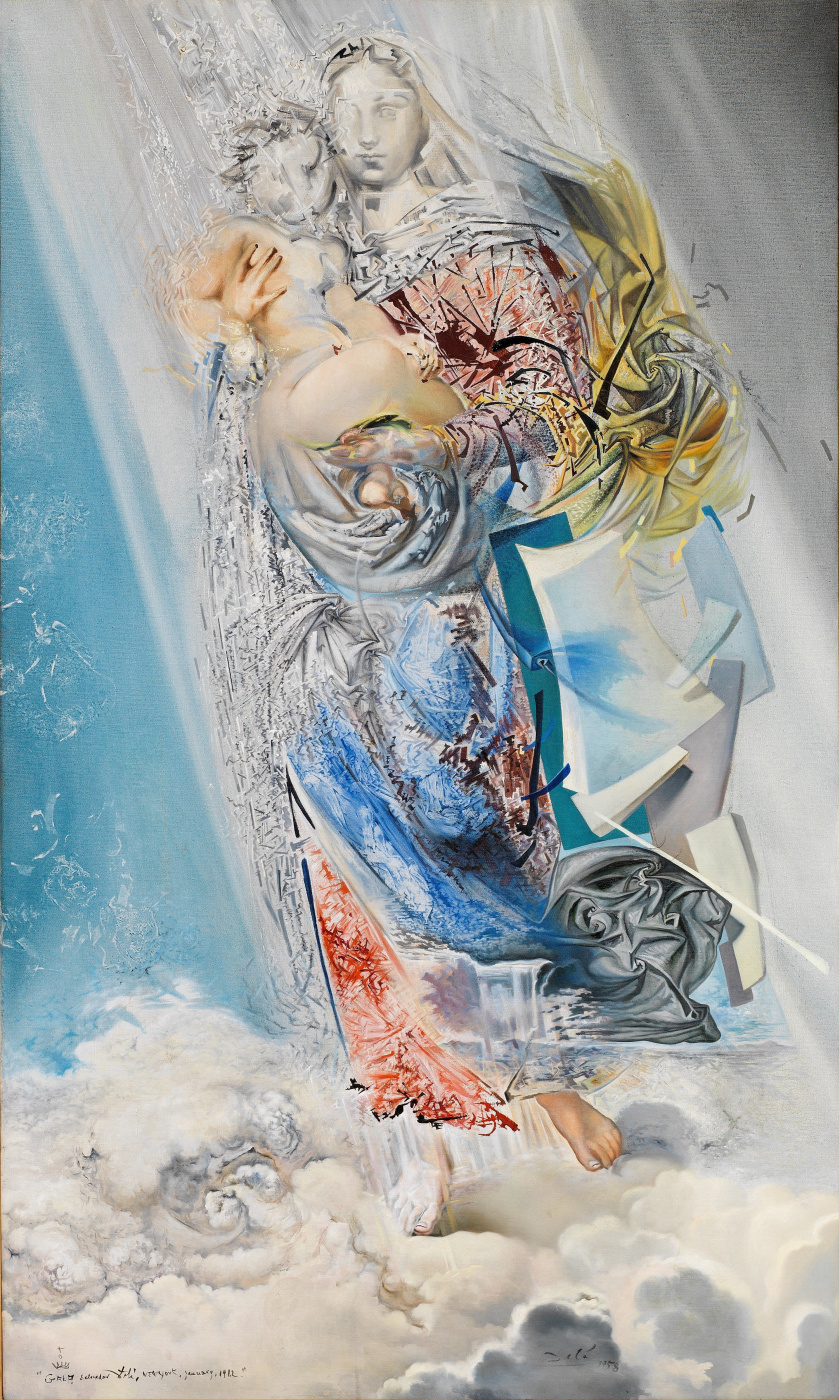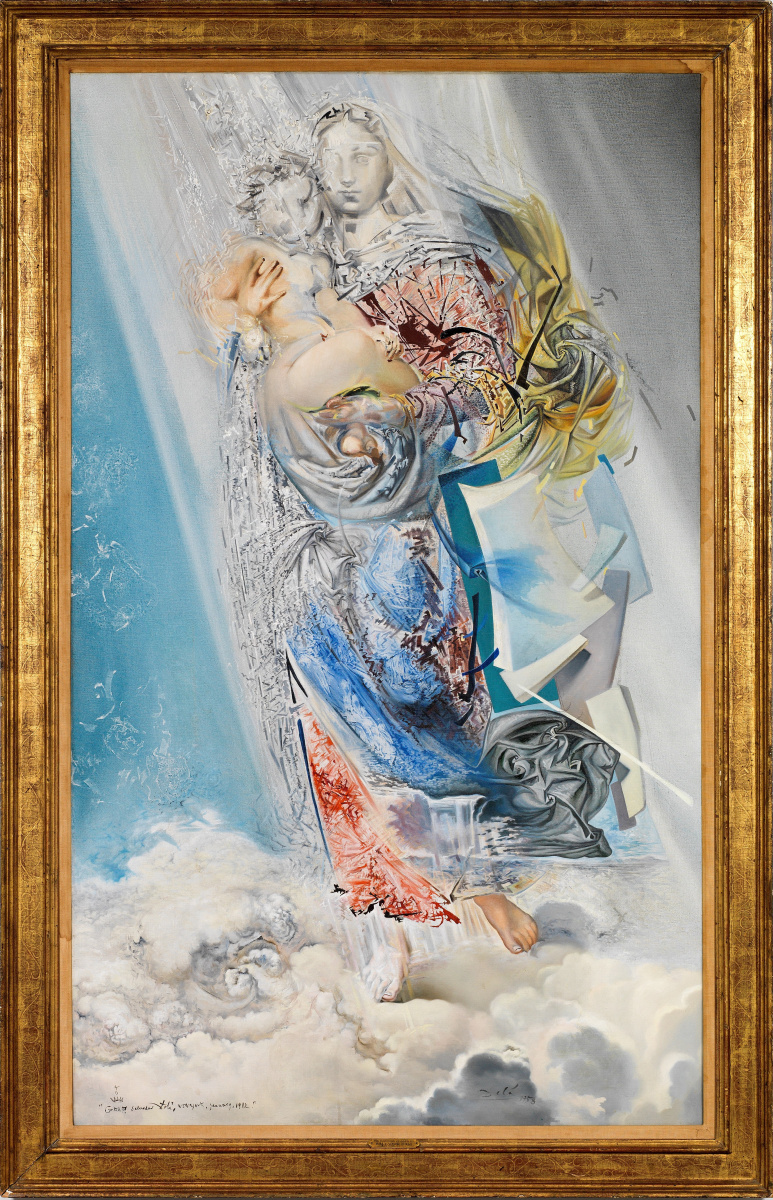log in
Enter site
Login to use Arthive functionality to the maximum
Cosmic Madonna
Salvador Dali • Painting, 1958, 152.5×91.5 cm
Description of the artwork «Cosmic Madonna»
"Cosmic Madonna" Is one of the masterpieces of Salvador Dali, uniting his interest in religion and nuclear physics. This canvas is one of the few works of the period of "nuclear mysticism", owned by a private collector, not museums and galleries. At the same time, for more than half a century, its location remained a secret. The painting was last publicly exhibited in 1965 at the Huntington Hartford Gallery of Contemporary Art in New York. Since then, evidence of her has been kept only in the form of photographs in which the artist poses against the background of his work, and reproductions in books and the online catalog of the Gala-Salvador Dali Foundation.
However, all these images were black and white, and the size of the painting, technique and materials, location and owner remained a secret, which added an aura of mystery to it. All these details became clear and a high-resolution photo of the work appeared when the collector decided to sell it in 2021.
Additional drama is given to the canvas by its alternative surreal name. It is written on the back of the canvas in Dali's famous ornate handwriting: "Van Gogh's cropped ear tip dematerializes from its terrifying existentialism, and the pi-meson explosion envelops Raphael's" Sistine Madonna ".
It is believed that it took Dali at least a year to create the Cosmic Madonna. This fact, coupled with the scale of the canvas itself, gives reason to call it a masterpiece. This was the opinion of the late Albert Reynolds Morse, the main collector of the artist's works and the creator of his museum in St. Petersburg, Florida.
Dali was inspired "Sistine Madonna" Raphael, but painted his image in the style of "nuclear mysticism". It mixed his "signature" surrealism, passion for discoveries in the field of nuclear physics and religious motives. Dazzling colors, delicate technique and majesty of the image make this work one of the most difficult works of the artist's post-war period.
Describing Dali's unique compositional style, art critic Eliot King remarked: “It seems that in The Cosmic Madonna, Raphael's Virgin Mary is disintegrating before our very eyes - or reuniting - in a burst of azure blue. Her formerly troubled face is a frequent topic of discussion among connoisseurs of Raphael - and the face of Christ is hardly material, since it dissolves in a stream of sparkling corpuscles ".
Salvador Dali often combined seemingly disparate thoughts and images. In The Cosmic Madonna, he refers us to the hypothesis of medieval theologians who believed that the Virgin Mary conceived through the word of God and, therefore, was impregnated through the ear. The above-mentioned alternative surreal name for the painting refers to the infamous ear Van Gogh. “The name is funny and shows Dali's penchant for unexpected twists and turns and certain riddles.- said the artist's biographer Paul Chimera. - I can imagine him in ecstasy radiating joy as he proudly presents this amazing masterpiece of nuclear mysticism. ".
The Cosmic Madonna is conceived as a modern reading of the Sistine Madonna, which Raphael wrote in the 16th century. Dali himself believed that the artist "must express the cosmology of the era in which he lives." This explains why he played surrealistically the theme of the Virgin and Child in his "corpuscular" or "atomic" period, depicting subatomic particles in a dazzling kaleidoscope of colors.
However, all these images were black and white, and the size of the painting, technique and materials, location and owner remained a secret, which added an aura of mystery to it. All these details became clear and a high-resolution photo of the work appeared when the collector decided to sell it in 2021.
Additional drama is given to the canvas by its alternative surreal name. It is written on the back of the canvas in Dali's famous ornate handwriting: "Van Gogh's cropped ear tip dematerializes from its terrifying existentialism, and the pi-meson explosion envelops Raphael's" Sistine Madonna ".
It is believed that it took Dali at least a year to create the Cosmic Madonna. This fact, coupled with the scale of the canvas itself, gives reason to call it a masterpiece. This was the opinion of the late Albert Reynolds Morse, the main collector of the artist's works and the creator of his museum in St. Petersburg, Florida.
Dali was inspired "Sistine Madonna" Raphael, but painted his image in the style of "nuclear mysticism". It mixed his "signature" surrealism, passion for discoveries in the field of nuclear physics and religious motives. Dazzling colors, delicate technique and majesty of the image make this work one of the most difficult works of the artist's post-war period.
Describing Dali's unique compositional style, art critic Eliot King remarked: “It seems that in The Cosmic Madonna, Raphael's Virgin Mary is disintegrating before our very eyes - or reuniting - in a burst of azure blue. Her formerly troubled face is a frequent topic of discussion among connoisseurs of Raphael - and the face of Christ is hardly material, since it dissolves in a stream of sparkling corpuscles ".
Salvador Dali often combined seemingly disparate thoughts and images. In The Cosmic Madonna, he refers us to the hypothesis of medieval theologians who believed that the Virgin Mary conceived through the word of God and, therefore, was impregnated through the ear. The above-mentioned alternative surreal name for the painting refers to the infamous ear Van Gogh. “The name is funny and shows Dali's penchant for unexpected twists and turns and certain riddles.- said the artist's biographer Paul Chimera. - I can imagine him in ecstasy radiating joy as he proudly presents this amazing masterpiece of nuclear mysticism. ".
The Cosmic Madonna is conceived as a modern reading of the Sistine Madonna, which Raphael wrote in the 16th century. Dali himself believed that the artist "must express the cosmology of the era in which he lives." This explains why he played surrealistically the theme of the Virgin and Child in his "corpuscular" or "atomic" period, depicting subatomic particles in a dazzling kaleidoscope of colors.



